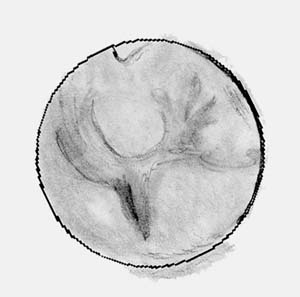
Sketched September 11, 2003 from the our downtown San Rafael public observing session in Marin County, CA at 11:55 p.m. pacific DST (daylight savings time) or 06:55 UT September 12. Seeing very good to excellent, transparency LM 3.0, full moon and streetlights nearby. We also showed Mars and moon to 150 people on the sidewalk during a 3 hour sidewalk astronomy session.
| Date: 09/12/03 Lat 37N, Long 122W, elev. 200 feet | Sketch Time (UT): 6:55, (local time): 11:55 DST |
| Central Meridian: 298° | Filters: none |
| Instruments: 12.5-inch f/5.75 Litebox traveldob reflector, plus f/9 AP180EDT refractor. | Distance from earth 0.39 AU, 58.5m km, 36.3m miles |
| Magnification: (9mm) 202x and (16mm's) 300x Nagler, and ZAO+binoviewer+barlow in AP180EDT for this sketch | Transp. 3/6, Seeing 9/10, Antoniadi (I-V): II |
| Apparent Size: 23.94" | Magnitude: -2.6 |
Details about the sketch: I used my f/5.75 12.5-inch Litebox reflector, 9 Nagler for 202x plus our f/9 AP180EDT refractor, binoviewer, Barcon barlow and 16mm ZAO eyepieces (300X) for this sketch. Sketched on the sidewalk plaza in town under the glow of streetlights, and in-between eyepiece viewers who wanted a look at Mars. Seeing softened just as I was finishing my sketch a little after midnight.
Details about Mars: Diameter 23.94 arc seconds (Jupiter is about 30 -50 arc seconds in diameter depending on its distance from earth). Central Meridian 298 - the imaginary line passing through the planetary poles of rotation and bisecting the planetary disk, and is used to determine the longitude during an observing session.
The terminator, where daylight ends and evening begins on Mars is back! The terminator is now on the right and the planet is rotating left to right. In my sketches, the planet rotates Martian east to Martian west to match most other images and sketches. The features rotate from left to right, but due to a stroboscopic effect - earth and Mars' rotations are different by less than an hour each day so it actually seems like the features are rotating in the opposite direction. It is just like if a tire wheel is rotating just a little slower than the frame rate in which you are taking a picture and it appears to rotate backwards because the wheel will not quite be making a full rotation for each snap shot. So if you look at Mars at exactly the same time each night, it will appear to rotate backwards. Anyway, now the terminator is on the other side of the disk as we have passed opposition and Mars' phase is 99%.
Syrtis Major is the prominent angular feature pointing (down) toward the north pole of the planet. To the left (east) is a lighter area called Syria. Between Syrtis Major and the shrinking south polar cap (south is up in all my sketches) is the large oval impact crater basin called Hellas. Last night there were lighter and darker areas in this basin. Tonight it is a uniform light color. The shape of Hellas looked more oval tonight than last night, too. Frequent observations will tell us if another big dust storm is brewing. Between Hellas and Syrtis Major is a little lighter-in-color feature called Iapygia. Next to the terminator is the zero meridian, or zero line of longitude and the bulblike Sinus Meriadini connected to the longer Sinus Sabaeus is rotating on. South of this feature is Mare Serpentis, sort of a spiderlike appearing feature. Just rotating on the disk, between Mare Serpentis and the terminator is Mare Erythraeum. And on the north polar area is both a hazy cloud over the area - the north polar hood, as well as some dark markings which are, depending to various maps, Nilosyrtis and Boreosyrtis and Ismenius Lacus.

White Oaks Home | Sketches Index | Mars 2003 Index | Back | Next